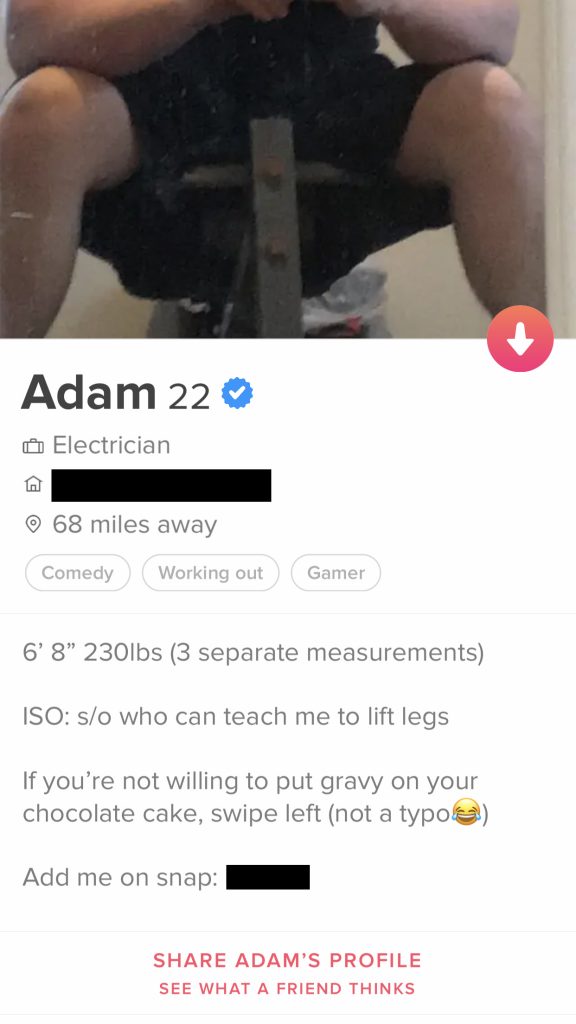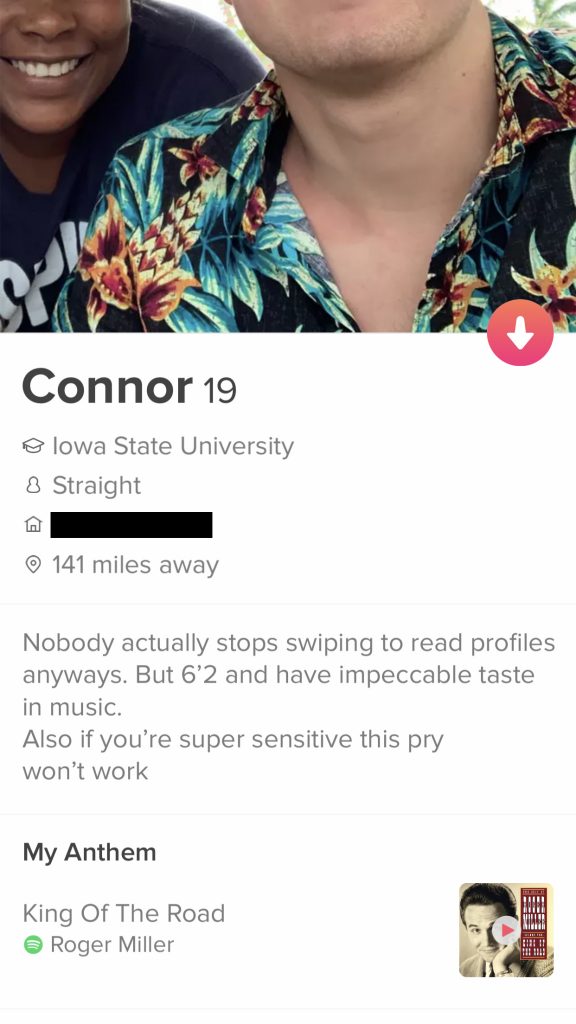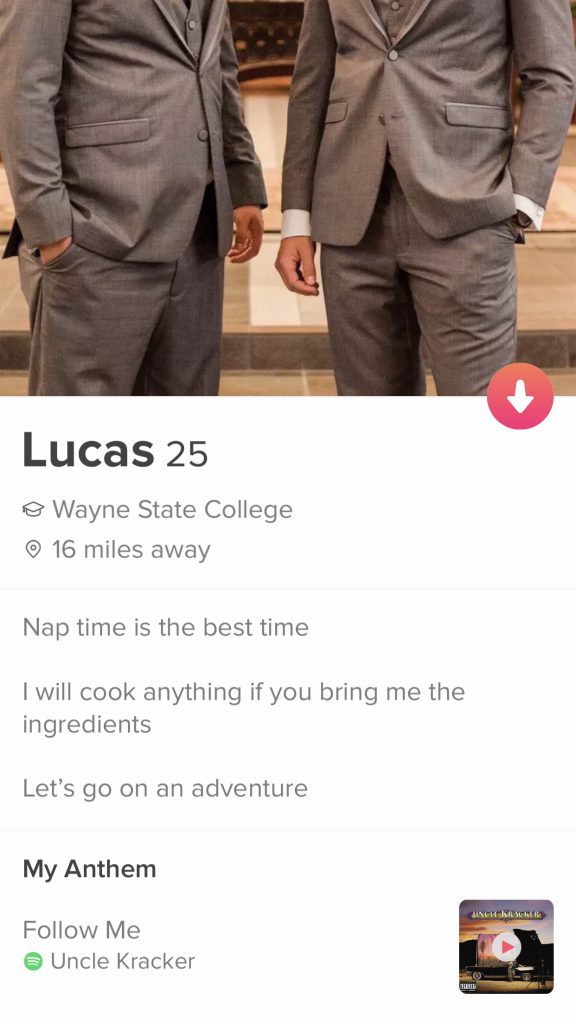Jake seemed like a nice guy. He is twenty and has a jawline that could cut glass. His music tastes are impeccable, with featured artists like Tyler the Creator and Mac Miller in his profile.
Jake’s bio read “Your mom would tell you to swipe right” with a little smirk emoji at the end. I’m not really impressed with his average level pick up line. I can let it slide.
His profile photos feature him lifting, holding a puppy, and flexing with his shirt off in a gym locker room. I was pretty attracted to the façade that he put together until the last photo of Jake. It was a photo of him and a friend, probably at a party hinted by red Solo cups and blue lighting, standing in front of a tapestry that read “Saturdays Are For The Boys.”
Was it petty for me to become uninterested in a person because of wall décor? Probably. But with previous experiences and conversations with guys with that tapestry, they turned out to be a complete jerk.
Plus, it was against one of my own personal rules to swipe right with a man that has a profile photo with that tapestry. I sigh and swipe left on Jake, never to see him pop up again on my list of possible Tinder matches. Onto the next bachelor that came in the form of Kaleb.
I am one of many college aged users with the dating app, Tinder. The app itself, along with other dating apps like Bumble or Hinge, is a popular trend among single college age students to have on their phones.
Tinder was introduced to the app store back in 2012, where it quickly appealed to a range of people and their sexual attractions. The app quickly became popular due to the easy access to start looking for love, hook-ups, or casual dating. Tinder has become one of the most popular dating apps among users and has shaped the modern dating scene.
“Tinder is a dating app that you create your profile and then you have pictures of yourself. Then you have like your age and where you live,” explained sophomore Sarah Severes, “Sometimes people will have what college they go to. You can put whatever you want in your bio. Some people have bios and some don’t.”
Severes described that her account was a collection of selfies that she felt confident in. She paired her profile photos with her favorite music, done by connecting her Spotify account to Tinder.

My own Tinder account was filled with a similar strategy as Severes. The only difference is that my bio reads “I enjoy long walks in the frozen food aisle.” This bio has caused a lot of pickup lines revolving around what my favorite frozen food is and guys saying they work at a grocery store, particularly with the frozen food.
After setting up a Tinder profile account about who they are, users are able to “swipe” through other users’ profiles. If a person is interested in someone, they swipe right to tell the app they are wanting to match with them. If the other person also swipes right, both are notified that they have matched and an option to message each other appears. If a person swipes left, it tells the app they are not interested in the other person and they will not appear again as an option.
Because of the easy format of looking through profiles and making yes or no decisions is what has helped in its rise of users. “I think it’s because it’s an easy, easy way to meet people. You don’t have to meet face to face. You can see if they’re cute or not, and then you or the other person who actually liked you can message first. Then based off of that, you can ask for their number or Snapchat,” said Severes.
College age students have different reasons for downloading Tinder, whether for the mingling aspects or avoiding face to face contact while browsing at singles in the area. “I think that it’s because of the mingling,” said sophomore Garrett Arbuckle on why the app is popular with college students, “You can personalize it the way you like and do it your own way. You can choose like where people are, the distance, and age range. I think it’s a way that’s so 21st century and so new time because people are a lot less willing to just go up and talk to people in person.”
Arbuckle described his Tinder as very bare, with not a lot of photos and no bio. He discovered with making his profile, that he did not have a lot of singular photos of himself. Arbuckle mentioned that he was also using a photo of him and a friend in hopes that possible matches would mistake him as the “more attractive one.”
“My reason for downloading Tinder was because I was lonely,” explained Arbuckle, “My senior year, I had a girlfriend and it was my choice I broke up with her right before graduation just because I didn’t want to move to college and meet someone. I didn’t really have a great track of relationships to start with. I was never the type of person that had a lot of girlfriends or whatever. And so actually, my friend encouraged me to download it.”
Tinder tends to be a bandwagon app for college singles. Users tend to be pressured into downloading the app for reasons that they know the number of other college students using it or through friends.
Tinder has become an app to use when a relationship end and a person wants to get back into the dating game. “I got out of a really long relationship recently. I was with the person for a couple for years. At first it was kind of to get back at her a little bit because I know the day after we broke up, she made a Tinder,” said senior Matthew O’Connell, “I was like that hurts a little bit. I don’t even really use [Tinder] all that much or anything like that, it’s just kind of on my phone.”
O’Connell collected photos from social media to put together his account. He tried to come up with a comical bio but feels that it is a bit corny.
If a Morningside student were to join Tinder right now, they would most likely see quiet a few familiar faces from their own campus. “I would say seven out of ten college students here at Morningside have [Tinder]. I would say like a good majority or most of the Morningside population,” said Arbuckle.
I personally can say that a good majority of the campus has the app itself. Sometimes matching with someone on campus can go one of two ways: things become really awkward and you never make eye contact again or you begin hanging out more.
Seeing a large majority of the other college students in the Siouxland area, like Briar Cliff University and Western Iowa Tech Community College, also on Tinder is a common occurrence. Sometimes with swiping does mean if you are willing to give your school pride to swipe right on a person from a rival school that you are attracted to.
“I did match with a Briar Cliff nursing student. Then I went to my first clinical and he was on the same floor as me,” said Severes, “It was very awkward. Then, I went back to my messages and like I saw that we had. So that was kind of weird.”
Tinder has varied results with those who do end up going on dates. Some go on one date and decide that there is zero connection. After the date, both people tend to stop talking and go back to swiping left and right.
Other results from Tinder is long term relationships with who they matched with. Some of the matches have resulted in marriages, although this is a rare result.
There is also a different experience using Tinder between females and males according to Severes. “I want to say this without sounding rude, but I feel like women have higher standards and men just swipe right if you like, look cute at all. It’s like, I know me and my friends we like look at like the bio and know the five things that they like. I think guys would just look at the first picture of like, she’s cute and swipe right,” said Severes.
Both Arbuckle and O’Connell feel like the usage of Tinder is not that different between male and female college students.
Tinder has also played a part in hookup culture, like one-night stands and friends with benefits. College students use the app to connect (quite literally) with others the same goal. They make it clear in their bios or with the first message with the other person.
“All you have to do is swipe left or right, you don’t even have to talk to the person you don’t even have to know the person. I know guys who just swipe right on every single profile they get or whatever and it’s like why are you doing that,” said O’Connell, “I guess [hookups] certainly seems to be kind of the trend at least among guys, I’ll say that.”
Each person has their own rules when it comes to swiping. Some rules can be that a person must have portrait photo of themselves or a bio that was written with actual effort. The odd rules that some have range from names that start with J are a no or a person wearing cowboy boots receives an automatic left swipe.
Once a match happens and conversation starts, it does a become a big question if that will lead to a date. From personal experience, conversations tend to happen for a few days before dying off or learning that there is no common interest.
I can personally count on one hand where there was a date that resulted from meeting on Tinder. Majority have been no connection with the guy and ultimately finding out that there is not a connection.
I am not the only one in this boat of feeling zero connection with the other person. Majority of us with failed Tinder dates turn around to repeat the process of swiping.
Disappointing? Yes. Do I blame Tinder? Slightly.
But with just how frustrating and unsuccessful Tinder is, it will probably stick around in the college environment for years to come until the next big dating app.
For now, Kaleb is twenty-two and his bio entails a sexual innuendo and his love of his truck.
Swipe left.



Leave a Reply